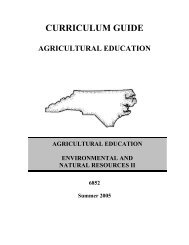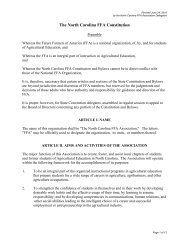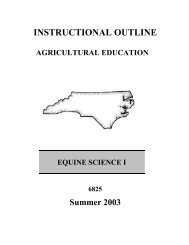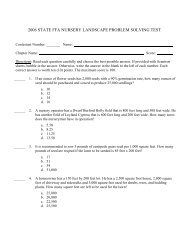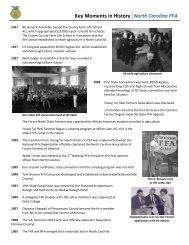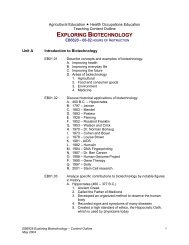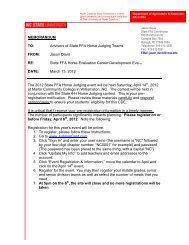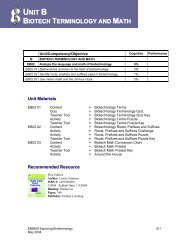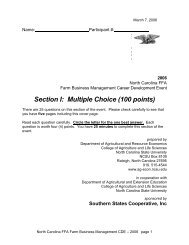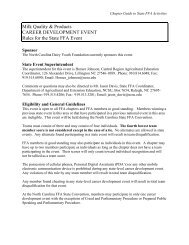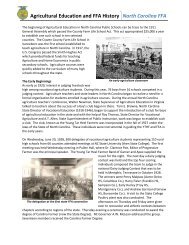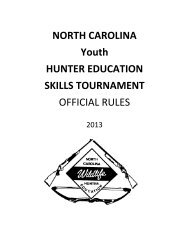Poultry Evaluation Test and Answer Key - NC FFA
Poultry Evaluation Test and Answer Key - NC FFA
Poultry Evaluation Test and Answer Key - NC FFA
You also want an ePaper? Increase the reach of your titles
YUMPU automatically turns print PDFs into web optimized ePapers that Google loves.
2009-2010 STATE <strong>FFA</strong> POULTRY EVALUATION KNOWLEDGE TESTContestant Number:Name:Chapter Name:Score:Directions: Read each question carefully <strong>and</strong> choose the best possible answer. If provided with Scantronsheets, bubble in the answer. Otherwise, write the answer in the blank to the left of each number. Eachcorrect answer is worth two (2) points. The maximum score is 50.1. The likelihood that birds will live up to their genetic potential is determined during their:a. First two weeks of life.b. First two months of life.c. First sixteen weeks of life.d. First month of life.2. What is the ventilation rate guideline for cage <strong>and</strong> floor raised birds?a. 1 CFM air flow per pound of bird live weightb. 2 CFM air flow per pound of bird live weightc. 3 CFM air flow per pound of bird live weightd. 4 CFM air flow per pound of bird live weight3. When should permanent beak trimming be performed on chicks?a. 2-3 days of ageb. 5-6 days of agec. 7-10 days of aged. 11-14 days of age4. What percentage of replacement egg-type chickens are raised in cages?a. 20%b. 30%c. 40%d. 50%5. What can be used as a drinking water sanitizer?a. Sulfurb. Chlorinec. Detergentd. Malathion6. Pullets normally are transferred to laying cages at:a. 12 weeks of age.b. 18 weeks of age.c. 24 weeks of age.d. 30 weeks of age
2009-2010 State <strong>FFA</strong> <strong>Poultry</strong> <strong>Evaluation</strong> Knowledge <strong>Test</strong> Page 27. The house temperature for cage brooding birds is reduced 4°F each week until the housetemperature reaches:a. 70°F.b. 75°F.c. 80°F.d. 85°F.8. Light stimulus is initiated when light enters the chicken’s eye. From 0.5 to 1 fc, the pituitaryreleases LH <strong>and</strong> FSH which causes:a. Improved night vision.b. Color recognition by the birds.c. An increased appetite.d. An increased growth of the ova.9. When is water consumption the highest for caged layers?a. Early morningb. Noonc. Mid-afternoond. Dusk10. An efficient worker riding a motorized cart can collect all the eggs from:a. 10,000 caged layers.b. 20,000 caged layers.c. 30,000 caged layers.d. 40,000 caged layers.11. The amount of light emitted by a light source is a:a. C<strong>and</strong>ela.b. Lumen.c. Foot-c<strong>and</strong>le.d. Watt.12. Decreased egg shell strength can be the result of:a. High air moisture level.b. Environmental temperature too low.c. Egg collection from young birds.d. Poor lighting.13. Which artificial lighting source has a short bulb life <strong>and</strong> low light efficiency?a. Fluorescentb. Inc<strong>and</strong>escentc. Mercury vapord. Metal halide14. In order to prevent dehydration <strong>and</strong> respiratory problems, maintain a relative humidity of:a. 5%-10%.b. 11%-19%.c. 20%-30%.d. 40%-60%
2009-2010 State <strong>FFA</strong> <strong>Poultry</strong> <strong>Evaluation</strong> Knowledge <strong>Test</strong> Page 315. Body weight measurements taken during the growing period assist in preparing pullets ofproper maturity level for the laying house. Weights are first taken when birds are:a. Two weeks of age.b. Eight weeks of age.c. Five weeks of age.d. Twelve weeks of age.16. Beginning at 20 weeks, daily water consumption per 100 hens ranges from:a. 1.00-1.25 gallons.b. 1.50-2.25 gallons.c. 2.50-5.50 gallonsd. 5.75-7.50 gallons17. Delaying light stimulation will:a. Increase egg size.b. Decrease egg size.c. Decrease feed consumption.d. Increase feed consumption.18. What is the slope per 100 linear feet for troughs for continuous running water?a. 1 inchb. 2 inchesc. 3 inchesd. 4 inches19. When egg production reaches its peak, the protein content of the pullet’s diet is at least:a. 10%.b. 12.5%.c. 15%.d. 17.5%.20. Provide light stimulation only when the pullet weight reaches:a. 1.5 pounds.b. 2.8 pounds.c. 3.2 pounds.d. 3.5 pounds.21. What percentage of all eggs laid are uncollectable?a. Up to 2%.b. Up to 3%.c. Up to 5%.d. Up to 7%.22. Eggs that develop cracks while the eggs are in the uterus <strong>and</strong> then are repaired while still in theuterus are called:a. Body checks.b. Oviposition eggs.c. Uterine eggs.d. Clutch eggs.
2009-2010 State <strong>FFA</strong> <strong>Poultry</strong> <strong>Evaluation</strong> Knowledge <strong>Test</strong> Page 423. Which cage type has all cages on one deck <strong>and</strong> connected to each other without walkways?a. Double deck cages.b. Four or five deck cages.c. Flat deck cages.d. Triple deck cages.24. When floor brooding, the lighting for the first week, at a light intensity of 3 fc, should be:a. 8-10 hours.b. 12-15 hours.c. 16-19 hours.d. 20-22 hours.25. Using high pressure sprayers <strong>and</strong> effective disinfectants help to eliminate:a. Insects.b. Disease.c. Predators.d. Mice.
2009-2010 State <strong>FFA</strong> <strong>Poultry</strong> <strong>Evaluation</strong> Knowledge <strong>Test</strong> Page 52009-2010 STATE <strong>FFA</strong> POULTRY EVALUATION KNOWLEDGE TESTANSWER SHEETAll references: <strong>Poultry</strong> Science Manual# <strong>Answer</strong> Reference1. c p. C-1312. a p. C-1353. c p. C-1334. d p. C-1325. b p. C-1366. b p. C-1377. a p. C-1328. d p. C-1409. c p. C-13810. c p. C-14111. b p. C-14012. a p. C-14113. b p. C-14114. d p. C-13215. c p. C-13416. c p. C-13817. a p. C-13818. c p. C-13819. d p. C-13920. b p. C-14021. d p. C-14122. a p. C-14223. c p. C-13724. d p. C-13325. b p. C-136



